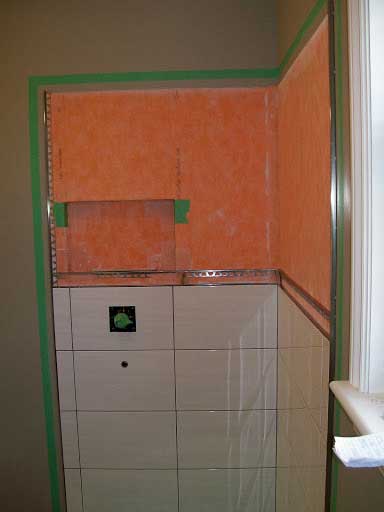GCloud
New Member
Hello everyone
My name is Grant. I've just stumbled across this forum and there's tons of great information here!
I'm about to undergo my first tiled shower and I've got a few (many actually) questions. I've looked at the ontariotile site and its been a lot of help, but I'm still a bit confused.
I'm replacing a prefab plastic shower base with a mortar base and center drain. The final shower will be about 3'X5' with full glass on two curbs extending to the walls...tile everywhere.
I'm planning on using kerdi on the floor and on top of concrete backerboard for the walls (is this the way to go?) and want to install a wire heating system under the base tile.
A couple questions:
I understand that without the heating system I've got to make a preslope...then install kerdi waterproofing...then make the mortar bed and install tiles, no? Where does the installation of the wires come into play? Do I follow the preslope-kerdi-mortar base procedure and then install the heating wires embedded in a later of thinset and then tile on top of this layer? Seems like a whole lot of layers!
How do I ensure water on the walls doesn't seep through the tiles and then outside the glass enclosure? Is this just a natural weak point? I can't imagine a whole lot of water spraying the joint where the glass meets the wall, but I feel like I should be able to spray water anywhere in the enclosure and have a guaranteed water tight seal.
I've also noticed on a number of sites that kerdi is applied to the walls and then the base. Is it not important to have the higher layers overlapping the lower layers?
I'm feeling like this is going to be a humbling experience! Any help would be much appreciated!!
Cheers
Grant
My name is Grant. I've just stumbled across this forum and there's tons of great information here!
I'm about to undergo my first tiled shower and I've got a few (many actually) questions. I've looked at the ontariotile site and its been a lot of help, but I'm still a bit confused.
I'm replacing a prefab plastic shower base with a mortar base and center drain. The final shower will be about 3'X5' with full glass on two curbs extending to the walls...tile everywhere.
I'm planning on using kerdi on the floor and on top of concrete backerboard for the walls (is this the way to go?) and want to install a wire heating system under the base tile.
A couple questions:
I understand that without the heating system I've got to make a preslope...then install kerdi waterproofing...then make the mortar bed and install tiles, no? Where does the installation of the wires come into play? Do I follow the preslope-kerdi-mortar base procedure and then install the heating wires embedded in a later of thinset and then tile on top of this layer? Seems like a whole lot of layers!
How do I ensure water on the walls doesn't seep through the tiles and then outside the glass enclosure? Is this just a natural weak point? I can't imagine a whole lot of water spraying the joint where the glass meets the wall, but I feel like I should be able to spray water anywhere in the enclosure and have a guaranteed water tight seal.
I've also noticed on a number of sites that kerdi is applied to the walls and then the base. Is it not important to have the higher layers overlapping the lower layers?
I'm feeling like this is going to be a humbling experience! Any help would be much appreciated!!
Cheers
Grant

